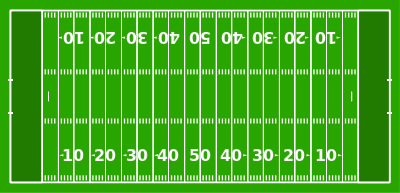American football field
The rectangular field of play of American football games measures 100 yards (91.44 m) long between the goal lines, and 160 feet (48.8 m) (53 1⁄3 yards) wide. In addition, there are end zones extending another 10 yards (9.144 m) past the goal lines to the "end lines", for a total length of 120 yards (109.7 m). When the "football field" is used as unit of measurement, it is usually understood to mean 100 yards (91.44 m), although technically the full length of the official field, including the end zones, is 120 yards (109.7 m).

White markings on the field identify the distance from the end zone. Inbound lines, or hash marks, are short parallel lines that mark off 1 yard (0.91 m) increments. In most forms of professional football in the U.S., including the National Football League and most forms of indoor football, the hash marks are in line with the goal posts, both being 18 feet 6 inches apart in the NFL and between 9 and 10 feet in indoor football. High school football and college football fields have hash marks significantly wider than the goal posts. The college football standard, which was the previous standard in the NFL (from 1945 to 1971), is 40 feet apart (20 yards from the sidelines)[1], introduced in 1993.[2][3] Previously, the college width was the same as the high school standard, at one-third of the width of the field (531⁄3 feet). Yard lines, which can run the width of the field, are marked every 5 yards (4.6 m). A one yard long line is placed near each end of the field; this line is marked at the center of the two-yard line in professional play and at the three-yard line in college play; this is to denote the line of scrimmage for a point after touchdown kick (the NFL moved up the line of scrimmage for such kicks to the 15-yard line in 2015, but the dash is still there to denote the line of scrimmage for a two-point conversion). Numerals that display the distance from the closest goal line in multiples of ten (up to the 50 yard line) are placed on both sides of the field every ten yards, with arrows right by the numerals to indicate the closer goal line; some fields may denote the goal line with a "G".[4][5][6] Weighted pylons are placed on the inside corner of the intersections of the sidelines, goal lines, and end lines. Including the end zones, the total area of an American football field is 57,600 square feet (5,350 m2).
The goalposts are located at the center of the plane of each of the two end lines. The crossbar of these posts is 10 feet (3.048 m) above the ground, with vertical uprights at the end of the crossbar 18 feet 6 inches (5.64 m) apart for professional and collegiate play and 23 feet 4 inches (7.11 m) apart for high school play.[7][8][9] The uprights extend vertically 35 feet on professional fields, a minimum of 10 yards on college fields, and a minimum of ten feet on high school fields. Goal posts are padded at the base, and orange ribbons are normally placed at the tip of each upright for the purpose of gauging wind direction and force.[7][8][9]
According to the high school rulebook recommendations, the field should be angled at approximately 1.2° (rising 1⁄4 inch per foot, or 1 in 48) upward from each sideline to the center of the field so that the center is 20 inches (51 cm) higher than the sidelines.[6]
Yard lines
Yard lines are a place on an American football field and Canadian football field marking the distance from the line of scrimmage to the closest goal line.[10]
White markings on the field identify the distance from the end zone. Inbound lines, or hash marks, are short parallel lines that mark off 1 yard (0.91 m) increments. Usually, every 5 yards (4.6 m) they run the width of the field. A one yard wide is placed at each end of the field; this line is marked at the center of the two-yard line in professional play and at the three-yard line in college play. Numerals that display the distance from the closest goal line in multiples of ten are placed on both sides of the field every ten yards.[4][5][6] Lines marked along the ends and sides of the field are known respectively as the end lines and sidelines, and goal lines.
References
- "High On The Hash". Sports Illustrated. (CNN). August 28, 1972.
- Chaptman, Dennis (March 26, 1993). "Moving hash marks should open offenses". Milwaukee Journal. p. C2.
- Clark, Bob (September 2, 1993). "New rules to keep coaches on toes". Eugene Register-Guard. Oregon. p. 9F.
- NFL Rules 2012, p. v, 1.
- NCAA Rules 2011–2012, pp. 18–19, 23–24.
- NFHS Rules 2012, pp. 11–12, 13, 28.
- NFL Rules 2012, p. 2.
- NCAA Rules 2011–2012, p. 18.
- NFHS Rules 2012, p. 14.
- http://www.sportingcharts.com/dictionary/nfl/yard-line.aspx